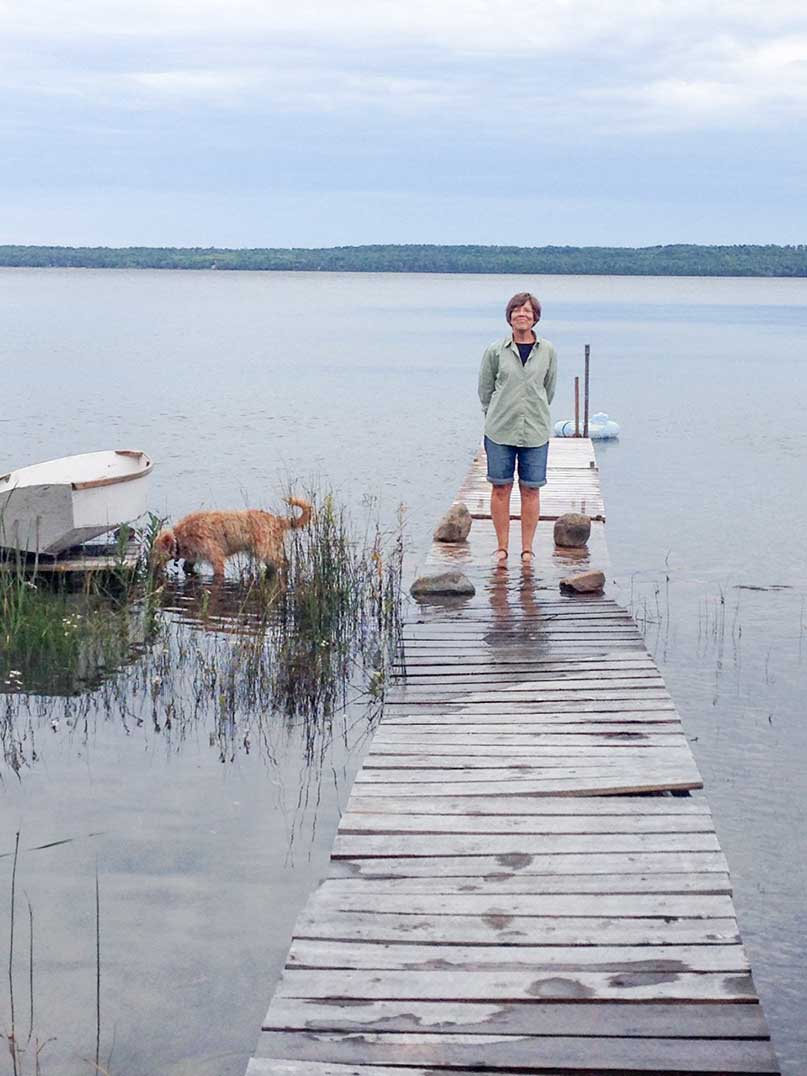EDITOR’S NOTE: Jim Nies is a retired educator and long-time Great Lakes sailor. He and his wife have spent the past eight years building a cottage in Kagawong, and they now split their time between Kagawong and Whitewater, Wisconsin. Jim is a former member of the Manitoulin Area Stewardship Council. He has been active in Great Lakes issues for many years.
by Jim Nies
We arrive back at the cottage, after an absence of six months, road weary and bedraggled. It’s the first day of May 2014. The forest seems oddly sere and empty—we last saw it luxuriant and suffused with autumn color. The rivulets, runnels, and rills are hurrying downslope, and the swales are full to overflowing. The bay appears to be a solid slab of dull, dark of ice.
It’s already well into afternoon when we pull into the driveway. The dog, extremely anxious to see how things have changed since he last surveyed the territory, explodes out of the car. We too are anxious to reconnoiter, but know things need to happen if we want to be settled before dark. The delights of hot and cold running water are never far out of mind.
Inside, six months of hard winter chill lies in the bones of the structure. We’ll need days to take that edge off, but there’s plenty of dry kindling and a pile of hard ash splits under the overhang, so soon the stove is ticking and clanking its way to warmth. A heave on the main breaker switch gives us light, with the wide-open fridge beginning to hum, superfluously.
But what about the water? Water for dish washing, for the indoor shower and tub (forget the outdoor shower for now), for the comfort and convenience of not having to trek up behind the garage to the iced-up outhouse. While it is possible to camp in a cottage— hauling buckets of lake water for dishes, sponge baths and toilet flushing—those of us accustomed to pressurized hot and cold tend to like it.
However, this cottage, like many others along the shore, has neither well nor water main; its domestic supply comes from a long black-poly line run from a pump-house on shore to a foot-valve resting on boulders about five feet below the surface of Lake Huron’s North Channel. And when you’re running a pipe into a lake, ice poses a problem.
The winter of 2013-14 had been a cold one, with unrelenting bitterness from November through March, driven by the widely hyped and vociferously excoriated ‘polar vortex.’ A loop in the jet stream, firmly anchored, ran up the west coast to high latitudes and then swooped down on the Midwest and East, overlaying the Great Lakes region with extreme cold. Week after week, month after month highs were in the single digits (F) and lows double digits below zero. At home in Wisconsin, we were advised by the city to keep a faucet trickling so our service line wouldn’t freeze solid.
By March the Great Lakes were almost completely frozen over—greater than 90 percent, perhaps a record. The cold continued well into April, thawing was slow, and on the first of May our bay on the North Channel was still iced over. As always, the melt had begun around the shoreline where all the incoming runoff lifted the edges, and where the sun warmed the dark shallows. But putting in the water line would require an icebreaker, namely me.
So, I survey the scene, then unlock the garage and pull the old chest waders off their peg. I struggle into these and begin hauling the hundred foot black plastic pipe down slope, out of the woods. I have a long way to go, over a disturbingly wide beach. Where the water once was when we bought the property are now exposed boulders, irregular puddles, and flats of mud.
The last autumn, at cottage shut down time, the beach had been wide and the water low, but like the frog in a slowly warming pot, we had rather gotten used to it. Water had been dropping and the beach expanding for the past 14 years. Since the summer of 1998 the water level of Huron/Michigan (all one body) had been trending downward, fluctuating seasonally as always, but in general going down. In January, 2013, it had hit the lowest point ever recorded, and, although recovered a bit, in October it was still way low.
Dropping water makes for an ugly beach, at least on our rocky stretch of it. Boulders slowly expose themselves covered with brown slime. In between are puddles and mucky flats that dry to cracked hardpan. It’s a wasteland.
But then, after a few rains, the boulders begin to blend with all the others along the shore, and the newly established water-land interface starts to seem natural. And, when no one’s looking, vegetation moves in quickly to claim new territory.
In the decade and a half of water drop, the bay receded over a hundred feet, and our waterfront changed from beach to meadow and proto-forest—with sedges, grasses, and ninebark and alder, and cedar, spruce, and willow. And cardinal flower, lots of it, forming a swath of jaunty red along the shore.
But, while we think we have it bad, conditions elsewhere are worse. Cottages along shallow shorelines have seen the water completely disappear from view. The ferry running to Washington Island, Wisconsin, can’t get into its normal dock. The dock in South Baymouth, Ontario, has to be modified before the Chi-cheemaun can come in from Tobormory. Channels are too shallow for boat passage, marinas are inaccessible, waterlines are sucking air. Dredging is necessary all around, from northern Michigan to southern Georgian Bay. The shipping industry needs to lighten its loads. And as the water recedes, phragmites marches in.
For me, on the first of May, 2014, ice is a bigger problem than the ominously wide beach. Heaving on the black poly line, I finally reach water. I mush through brash ice for a few paces, and then reach the more solid stuff where I have to step up and on, letting my weight sink and detach rotten chunks. It is slow going, but with time I reach a depth sufficient for an initial deployment of the foot valve but still safely below the top of my waders. I lower the pipe-stand to the bottom.
From that point on, hot and cold running water is only a matter of ordinary plumbing—connecting the line to the pump, using the Guzzler hand pump to draw water up the line into the jet pump, re-connecting all the open lines in the cottage, putting a few capfuls of bleach into the particle filter housing to “shock” the system, and then, once things are running clear, putting in a new particle filter and turning on the UV system and water heater. All this is accomplished rather easily, but with a numb and vividly pink lower torso.
Then, with a functioning kitchen sink, reduced reliance on the outhouse, and the prospect of hot showers, we settle on a sofa, afghans around our shoulders and a bright fire in the wood burning stove. We’re back, back once again in our ever most favorite place.
Happy as clams, we are, but worried nonetheless. That vast and waterless beach out front is deeply disturbing. As we sit near the stove, sipping little somethings, we ask ourselves where all the water has gone, and we wonder if it will ever come back. We try to reassure ourselves that this is a widespread problem and we are not alone in our worry, and maybe something can and will be done.
In fact, a deepening dread has been building across the upper Great Lakes—from Green Bay, along the upper west Michigan shore, through Les Cheneaux islands, along the North Channel, and around and down Georgian Bay. Not only is the disappearing water costing lots of money, but it’s messing up the ecology—diminishing wetlands, reducing the manoomin harvest, preventing trout and salmon from getting into their spawning rivers, and facilitating the spread of invasives. The whole way of life across the Great Lakes north is threatened.
What if, we wonder, this 14-year long decline continues? What if the water continues to drop and drop and drop?
Naturally, attention across the upper Great Lakes turns to the St. Clair River, which drains out the bottom of Lake Huron. The St. Clair has been heavily dredged for over a century, and that combined with mining and erosion, has dramatically increased the outflow, up to something like 120 billion gallons a day.
And, naturally, attention turns to the International Joint Commission (IJC), which is charged by the Boundary Waters Treaty of 1909 to deal with Great Lakes levels and flows. Serendipitously, it turns out that the IJC has been studying the upper Great Lakes for a number of years as part of the anticipated revision of its Lake Superior Regulation Plan. (The outflow of Lake Superior, controlled at the St. Marys River in Sault Ste. Marie, is an important source of water for Michigan/Huron/Georgian Bay.)
In 2011 the IJC’s Study Board holds hearings all around the watershed, and they get an earful about the amount of water being lost down the St. Clair. In 2012 the IJC commissioners themselves, after reviewing the Study Board’s recommendations, hold hearings—and again they hear about the St. Clair. In April, 2013, the IJC sends its revised Lake Superior plan to the governments of the U.S. and Canada; and along with it, the recommendation “that the governments of Canada and the United States investigate structural options (in the St. Clair) to restore water levels in Lake Michigan-Huron…” The commission suggests that it might be a good idea to put some kind of control on the only part of the Great Lakes without any. They recommend flexible controls that can moderate the extremes of high and low water.
Apparently, that’s all Mother Nature needs to hear. In April 2013 the level stands at 576.61 feet, very low; but by the end of the year, thanks to a wet fall, is has climbed a bit, to 577.33. Then the polar vortex cranks up! The Great Lakes freeze almost solid; and being covered in ice, they are protected from the typically huge evaporation that occurs when cold, dry winter winds blow over relatively warm water.
So, when we arrived back at the cottage in May 2014 and found all that ice on the bay, the level stood at 578.31, up over two feet from the 2013 nadir. However, the water was still low, and the beach still ever so wide.
The day after arriving, and after enjoying a hot shower, I write in my journal:
‘The water is up, not way up, but up some from last October, and it’s still early in the water cycle. Perhaps over the next two months we’ll make it all the way up to the long-term average.’
It turns out to be a wet spring, and the water does inch up. On July 1 the water has risen above the historical average. I’m astounded. And then we have heavy thunderstorms. On July 4, the 100-foot boardwalk we built (out of planked-over cedar logs) to get to water across the flats, starts to float. We weight it down with boulders. And then we have (heavy) rain. On September 5, a seiche lifts the decking off the pier. On October 3 high winds push big waves over what used to be dry land and the boardwalk is ripped up and washed in. When I pull the water line on October 7, the level is standing at 579.20.
Then comes the winter of 2014-2015, and again it’s cold. The polar vortex again gives us special weather statements and cold temperature precautions, and early in March Great Lakes ice cover is again extensive, nearly 80 percent.
Surviving this winter, we arrive back at the cottage on the second of May 2015, after an absence of six months, road weary and bedraggled. We find, unlike the previous year, that the bay is mostly open. We see icebergs drifting by, but putting in the water line is routine.
On May 27 I write in my journal:
‘Three hours of heavy downpour last night, coming down on an already saturated forest—so lots of runoff. Tyson’s creek, a raging torrent. After lunch, suspecting there might be considerable water to watch, we decide to walk the river trail to the falls (which we have not done yet this year). What we see is stupendous—surging power, twisting and shouldering its way from the thundering cataract all the way to the bar at the mouth of the bay.’
The water level continues to climb, and by mid-summer we are wading knee deep where the cardinal flowers once displayed their fiery blooms. The actual fire pit has disappeared beneath the foam, and big waves have piled black windrows of dead vegetable matter high along the shore. By late summer the level is almost 4 feet higher than the 2013 low.
That’s a lot of water—four feet straight up over a surface area of nearly 46,000 square miles (119,000 sq km). “Unprecedented and historic,” according the U.S. Army Corps of Engineers.
But then we get to the winter of 2015-2016, and this time, no ice. Instead of polar vortex, it’s El Niño. We wonder if the change of pattern and the lack of ice are going to stop the rise and re-start the drop. But apparently no, not so much. Much of the winter is chilly, misty, and gray, but with no biting winds causing lake-effect evaporation. Instead, long bands of moisture stream up from the Pacific and the Gulf piling onto Lakes Michigan and Huron. In April, much of northeast Ontario receives a rainfall warning and then a snowfall warning, and then a rainfall warning, and the water level is above where it left off last October, and over 5 inches higher than it was same time last year.
And then, once again, the calendar says May.
And then, once again, we’re back at the lake—in time to open up, light a fire in the stove and put in the water line. The dog is more subdued than in previous years, recovering from a knee operation. But, for us, putting in the water line is less of a chore than normal. The day is bright and warm—and flat calm. While there’s a small pile of snow on the back deck, there’s no ice at all on the bay. After I walk the foot valve out as deep as the chest waders will allow, we use the rowboat to tow the pipe-stand out to the full extent of the line. We’re in deep.
For the water is deep. It’s considerably higher than it was last fall. It’s creeping under the dock sections we stored high and dry last October, and lapping disturbingly close to the pump-house. Logs and various bits of flotsam have been flung where, in my memory, water has never been before.
Seeing all this I wonder what’s to be made of such extremes? What does the future hold? With the changing climate, will we eventually enter long-term drought, as a number of, forecasts predict, and see the Great Lakes drain back to—and below—the record low? Or will the warmer atmosphere’s ability to hold more moisture keep filling them to the brim? Or will we see wild swings like those of the past few years?
Right now, high water has left organizations dedicated to water preservation pretty much washed out. The dread that accumulated during the years leading up to the low point in 2013 has eased. The IJC’s recommendation that the U.S. and Canada investigate structures to regulate the flow of the St. Clair River seems dimly remembered. People along the Wisconsin shoreline are starting to worry about—erosion.
And me? I sit here on the lower deck on a summery day in 2016, watching errant breezes swirl catspaws around the bay and listening to waves slap high along the highest shore. Mergansers hunt for lunch where flowers bloomed. I am thankful for what the polar vortex and El Niño have done.
I stare across the bay…and try to see the future. But in spite of the bright sun, what I see is cloaked in fog. Will Mother Nature get back to being natural, with the Great Lakes following the cycles they have followed for thousands of years? Or will climate change wreak havoc?
If anything is visible through the fog, it’s uncertainty. And, given that we humans have contributed to this uncertainty, I see quite clearly the need for planning and for prudence. I think it makes sense to ask human science and human engineering to pitch in and give Mother Nature a helping hand.





